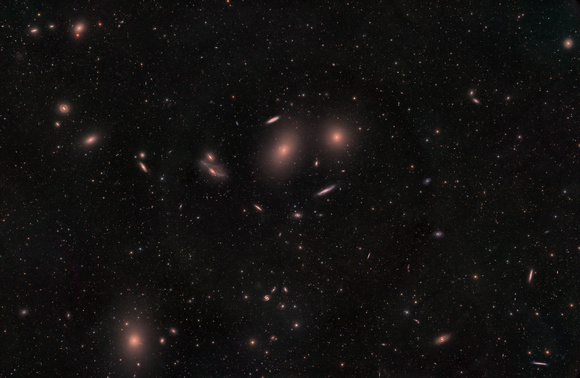Markarian's Chain / Virgo Galaxy Cluster
The Virgo Cluster incl. Markarian's Chain, April 2023
Televue 127is telescope and A-P Mach2 mount
ASI6200MM Camera, Baader BB & 6.5nm Ha Filters
Lum (130 x 120s exposures, Bin 1x1 Gain 100)
RGB (3 x 60 x 120s exposures, Bin 1x1 Gain 100)
HOS (23 x 600s exposures, Bin 1x1, Gain100)
Total Integration Time = 14.2hours
The immense Virgo Cluster is comprised of 1300 to 2000 individual galaxies about 58 million light years away. It is the nexus of the "Virgo Supercluster" of galaxies, or which the Milky Way and our local group of galaxies are also members. The Virgo Cluster itself, however, is approx 58 million ly away and as the image indicates contains a mixture of both elliptical, diffuse galaxies, and well formed spirals. in the upper left quadrant of this image is Markarian's Chain of galaxies which is the subject of many astro-images. The three largest elliptical galaxies in this image are contained in Messier's catalogue asa M84, M86, and M87, in addition to dozens of catalogued within NGC and IC. M87 contain the super-massive black hole that was the subject target of the first Event Horizon Telescope image in 2019. There are literally hundreds of galaxies just within this image, making the Virgo Cluster just about as crowded as space gets.
The concentration of galaxies gives off its own sky-glow that is visible, but downplayed in this image. The gravitational interaction between the galaxies has left many inter-galactic stars which are likely responsible for this glow. Also a lot of the interstellar space is filled with a hot (50 million degrees C) rarefied X-ray emitting plasma.
Curiously and for some unknown reason dubbed the "Cosmic Broom", the Virgo Cluster galaxies have been swept clean of its hydrogen forming gases, and there is little new star formation taking place in them. To investigate this, I shot frames using a hydrogen-alpha filter, that indeed showed very little signal outside of the cores of a select few galaxies.
Poor sky conditions were thwarted by taking many frames to produce this image (many of which were also rejected). It also took a lot of attention to individual galaxies to bring out details.


